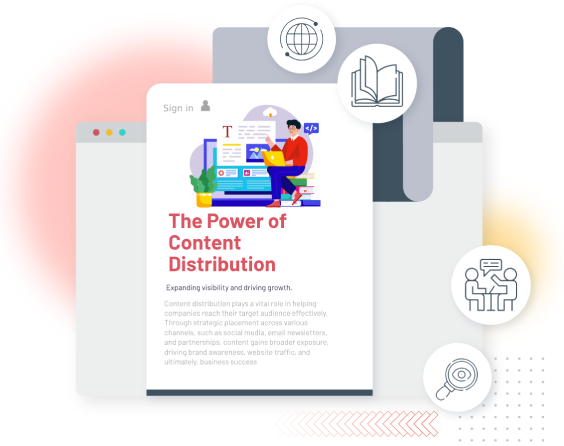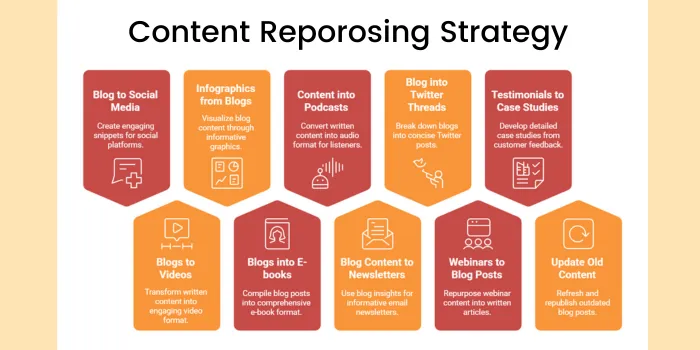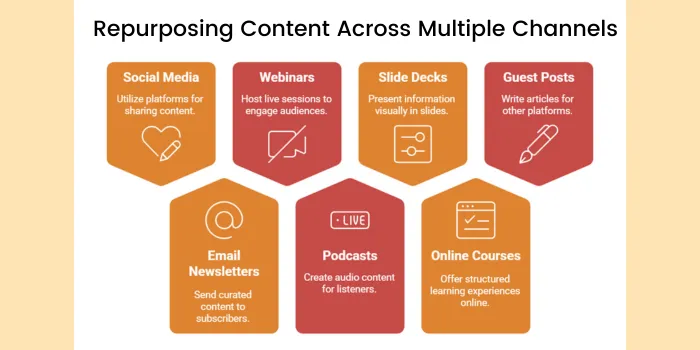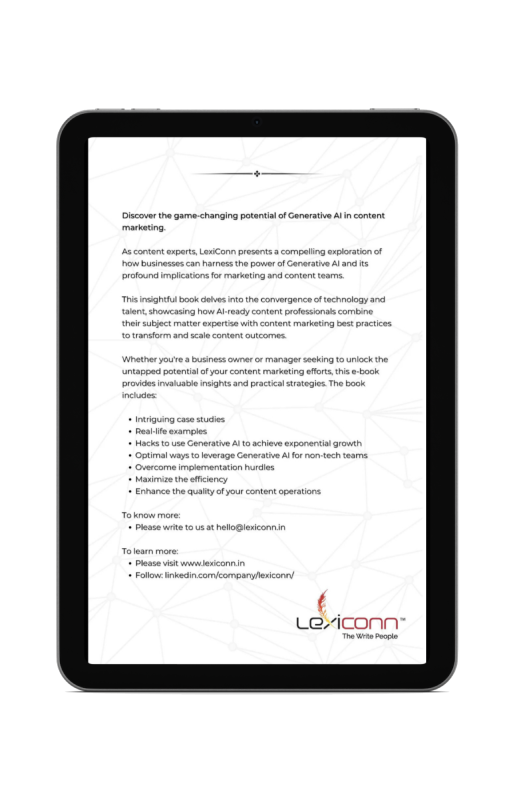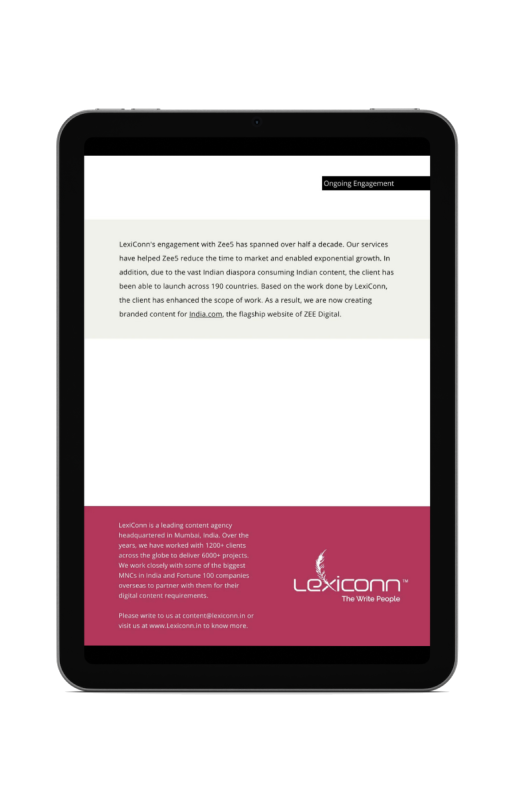Source
You’ve spent hours writing a great blog post. Now, what if you could transform that one piece of content into a podcast, a social media post, a video, or even an email series—without starting from scratch each time? Pretty cool, right?
That’s content repurposing! It’s all about getting more value from the content you’ve already created, reaching more people, and saving time in the process. In this guide, we’re going to show you how to turn your content into a multi-channel powerhouse, making sure your hard work gets seen everywhere it matters. Let’s see how to turn one piece of content into multiple formats!
What is Content Repurposing?
Content repurposing is the process of transforming one piece of content into multiple formats for content distribution across various channels. Instead of creating new content for every platform, repurposing allows you to extend the life of a single piece of content and deliver it in different ways to suit various audience preferences.
Why Repurposing Content is Crucial for Multi-Channel Success
1. Save Time and Resources
Creating content from scratch for every platform takes time and effort. Content repurposing maximizes the impact of a single piece of content and maximizes the resources you’ve already invested in. It’s an efficient way to scale your content marketing efforts without burning out your team.
2. Reach More Audiences
Each platform has its own unique audience. Some people prefer reading blog posts, while others are more inclined to watch videos or listen to podcasts. By repurposing your content into different formats, you can connect with a wider audience and make sure that your message reaches them where they are most active.
3. Boost Engagement
Repurposing your content across multiple channels doesn’t just increase its content reach; it also keeps your audience engaged. When content is presented in different formats—like visual infographics, short video clips, or podcast episodes—it adds variety to your strategy and encourages more interaction from your audience.
Best Repurposing Strategies to Maximize Your Content
Repurposing content helps you get more value from your efforts by making content reach different audiences across multiple platforms. It strengthens your brand presence and make sures your content stays relevant longer. Here are the best strategies and how to implement them effectively:
Source
1. Blog to Social Media Snippets
Social media audiences have shorter attention spans. Bite-sized content keeps them engaged while driving traffic back to your full blog.
How:
- Extract key quotes, statistics, or actionable tips from your blog.
- Create short posts for Twitter, LinkedIn, Facebook, or Instagram.
- Pair text with eye-catching visuals, GIFs, or carousel posts.
- Use scheduling tools like Buffer or Hootsuite for consistency.
2. Reuse Blogs into Videos
Video content has higher engagement rates, improves retention, and performs well on social media and search engines.
How:
- Summarize key points into a short script.
- Use tools like Lumen5, Canva, or Animoto to turn text into videos.
- Add captions, animations, and background music for better engagement.
- Post on YouTube, TikTok, Instagram Reels, or LinkedIn.
3. Create Infographics from Blogs
Infographics simplify complex ideas, boost shareability, and help visual learners grasp information quickly.
How:
- Identify key takeaways, data points, or step-by-step processes from your blog.
- Use Canva, Piktochart, or Venngage to design an infographic.
- Share on Pinterest, LinkedIn, Instagram, and your blog.
4. Transform Blogs into E-books
E-books establish authority in your industry, generate leads, and provide in-depth value to your audience.
How:
- Gather related blog posts into one cohesive document.
- Format content using tools like Adobe InDesign or Google Docs.
- Add visuals, case studies, and additional insights.
- Offer the e-book as a lead magnet on your website.
5. Repurpose Content into Podcasts
Podcasts cater to busy audiences who prefer audio content, expanding your content reach and brand awareness.
How:
- Record yourself discussing key topics from your blog.
- Use tools like Audacity or Anchor for recording and editing.
- Upload episodes to platforms like Spotify, Apple Podcasts, or Google Podcasts.
- Repurpose interviews or webinars into podcast episodes.
6. Turn Blog Content into Email Newsletters
Emails keep your audience engaged and drive traffic to your site without creating entirely new content.
How:
- Summarize the main points and add a personal touch.
- Include a call-to-action linking back to the full blog.
- Use email platforms like Mailchimp or ConvertKit for automation.
7. Break Blog Content into Twitter Threads
Twitter threads boost engagement, position you as an expert, and encourage conversations.
How:
- Divide blog insights into a series of short tweets.
- Number them to create a clear thread.
- Add relevant hashtags and engaging visuals.
8. Turn Webinars into Blog Posts or Social Media Content
Webinars often contain valuable discussions that can be repurposed into evergreen content for multiple platforms.
How:
- Transcribe the webinar using tools like Otter.ai.
- Extract key insights and structure them into a blog post.
- Create social media quotes and carousel posts from key takeaways.
9. Reuse Customer Testimonials to Case Studies
Case studies build credibility, showcase real-life impact, and attract potential clients.
How:
- Collect customer feedback and success stories.
- Format them into detailed case studies with real-world results.
- Share as blog posts, social media posts, or PDFs.
10. Update and Republish Old Content
Refreshing content helps maintain SEO rankings, keeps your site relevant, and saves time compared to writing new posts.
How:
- Identify older blogs that performed well but may be outdated.
- Update stats, examples, and visuals.
- Republish on your website and share on social media.
How to Repurpose Content Across Multiple Channels
Once you’ve repurposed content, the next step is to distribute the content effectively. This makes sure your content reaches the right audience in the right format, increasing engagement and maximizing your content’s value. Here’s how to do it:
Source
1. Social Media
Social media is one of the easiest and most effective ways to repurpose content. Each platform has its own format and audience preferences, so adjusting your content accordingly can help boost engagement.
How to do it:
- Create short posts – Extract key insights, tips, or quotes from your blog, e-book, or video.
- Use eye-catching visuals – Pair your text with images, GIFs, or carousel posts to make them more engaging.
- Post short video snippets – If you’ve created a longer video, break it down into bite-sized clips for platforms like Instagram Reels, TikTok, and YouTube Shorts.
- Engage with your audience – Use interactive content like polls, Q&A sessions, or live discussions to encourage participation.
- Use hashtags and trending topics – This helps increase visibility and make your content reach a broader audience.
Why it works:
Social media content is quick to consume, easy to share, and helps drive traffic back to your website or original content.
2. Email Newsletters
Email marketing keeps your audience engaged and encourages them to return to your website. Repurposing content for email newsletters can save time and help maintain consistent communication with subscribers.
How to do it:
- Summarize your blog post or e-book – Pick 2-3 key takeaways and turn them into a short, engaging email.
- Personalize your messaging – Use your subscribers’ names and tailor content based on their interests.
- Include a call to action (CTA) – Link back to the full content and encourage readers to check it out.
- Use visuals and formatting – Break up text with bullet points, images, or infographics for easy reading.
- Automate email sequences – Schedule follow-up emails with additional insights or related content.
Why it works:
Email marketing helps nurture leads, keeps your audience informed, and drives traffic to your site.
3. Webinars and Live Streams
Hosting a webinar or live stream is a great way to expand on a topic covered in a blog post or e-book while engaging directly with your audience.
How to do it:
- Choose a topic with high engagement – Look at which blog posts or content pieces performed well and use them as the foundation for your webinar.
- Promote in advance – Use social media, email, and website banners to get people to sign up.
- Use slides or visuals – Make your presentation more engaging by including key points, charts, and videos.
- Encourage live interaction – Host a Q&A session, take polls, or invite guest speakers to keep the session engaging.
- Repurpose the webinar – After the event, turn the recording into a YouTube video, podcast, or blog post summarizing key takeaways.
Why it works:
Webinars and live streams create real-time engagement, build credibility, and can be repurposed further into multiple content formats.
4. Podcasts
If you have a well-researched blog or long-form article, turning it into a podcast allows your content reach an audience that prefers audio content.
How to do it:
- Record a solo episode – Simply read and expand on key points from your blog post.
- Invite guests or experts – Bring in industry professionals to discuss the topic in more detail.
- Keep it conversational – Avoid reading directly from your blog; instead, explain concepts in a more natural tone.
- Distribute on multiple platforms – Upload your podcast to Spotify, Apple Podcasts, and Google Podcasts.
Why it works:
Podcasts lets your content reach busy professionals who prefer learning on the go, expanding your audience beyond readers.
5. Slide Decks and Presentations
Repurposing a blog post, e-book, or research paper into a slide deck can be useful for webinars, business presentations, or platforms like SlideShare.
How to do it:
- Summarize key points into slides – Use bullet points, charts, and graphics to highlight key takeaways.
- Use simple, clear visuals – Keep slides uncluttered with minimal text.
- Share on LinkedIn and SlideShare – These platforms help professionals discover and share insights.
Why it works:
Slide decks offer a professional way to present content in meetings, webinars, and industry events.
6. Online Courses & Tutorials
If your content covers an in-depth topic, consider turning it into an online course or tutorial.
How to do it:
- Organize content into modules – Group related blog posts or video content into structured lessons.
- Use a mix of formats – Include text, video, quizzes, and downloadable resources.
- Host on platforms like Udemy or Teachable – These sites help your content reach a wider audience.
Why it works:
Courses help establish authority in your industry and can generate additional revenue.
7. Guest Posts & Syndication
Repurpose your content by publishing it on third-party websites, reaching a new audience.
How to do it:
- Rewrite blog posts for different websites – Adjust tone and examples to match the audience of each platform.
- Submit to content syndication platforms – Websites like Medium, LinkedIn Articles, and GrowthHackers allow republished content.
- Pitch guest posts – Offer valuable insights to industry blogs and link back to your original content.
Why it works:
Guest posting and syndication increase visibility, build backlinks, and establish you as an expert.
Tips for Effective Content Repurposing
1. Stay Consistent
While repurposing content into different formats, ensure that your core message remains consistent across all platforms. This will help maintain your brand’s voice and ensure that your audience receives a clear and cohesive message.
2. Know Your Audience
Different platforms attract different audiences. Understand where your audience spends their time, and adjust your content accordingly. For example, more formal content might perform better on LinkedIn, while short, punchy videos may be more suitable for TikTok or Instagram.
3. Track Performance
It’s important to track the performance of your repurposed content across channels. See which formats are getting the most engagement and adjust your strategy based on these insights.
Tools to Help with Content Repurposing
Several tools can make content repurposing easier, such as:
- Canva for creating engaging graphics and infographics.
- Lumen5 for turning blog posts into video content.
- Buffer for scheduling social media posts across different platforms.
- Hootsuite for managing and distributing content.
Make the Most Out of Your Content
Content repurposing is a smart way for businesses to extend the life of their marketing efforts. Instead of letting valuable content fade, you can transform it into multiple formats—blogs, videos, social media posts, and more—to reach a wider audience and boost engagement.
By experimenting with different formats and tracking performance, you’ll discover what resonates best with your audience. A well-planned repurposing strategy ensures your message is always relevant, reaching the right people at the right time on the right platforms.
Ready to maximize your content’s potential? Start repurposing and watch your reach grow!
How LexiConn Can Help You Repurpose Content
At LexiConn, we transform your content into engaging formats that fit different platforms, ensuring maximum reach and impact. Our services include:
- Blog to Social Media Snippets – Turn long-form content into bite-sized posts.
- Articles to Videos & Infographics – Repurpose written content into visuals for better engagement.
- Webinars & Podcasts to Blogs – Reuse audio/video content into insightful articles.
- Ebooks to Newsletters & Guides – Break down extensive content into valuable resources.
- SEO Optimization for Repurposed Content – Ensure every format ranks and performs well.
Experience our expertise with a FREE pilot project!
Book a 30-minute free consultation today and see how we can bring new life to your content!
Boost your Content Strategy.
Download the Free eBook now.
Unlock Generative AI's potential for content marketing success. Unearth its impact on teams and businesses. Witness real-life examples and case studies, showcasing AI-driven content ingenuity.
